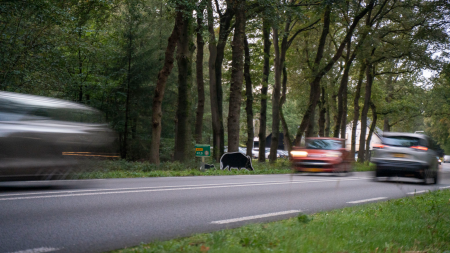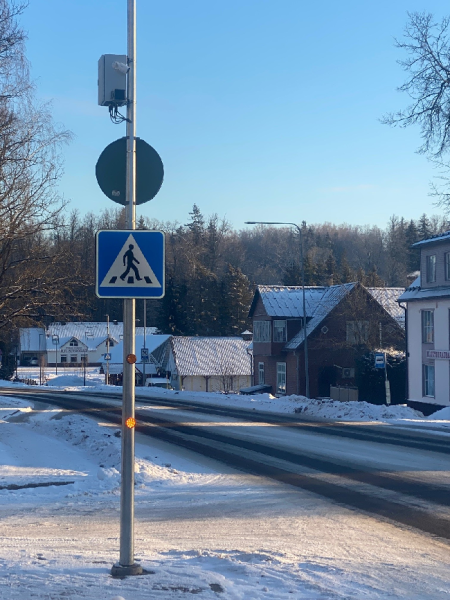Public authorities

Monday, June 17, 2024
Our experience shows that most road accidents are caused by human error. Various analyses carried out by ALSA show that most road accidents are caused by inappropriate driver behaviour.
In order to manage road safety proactively, it is necessary to have a detailed and rigorous knowledge of the performance and behaviour of each driver in order to know their skills and behaviours, as well as to track their evolution over time.
To this end, ALSA has invested in technology in more than 3,700 vehicles in Spain that allows us to measure speeding, monitor various parameters that reflect driving style and detect various driver behaviours using innovative smart camera technology.
These smart cameras are based on "machine vision” and "artificial intelligence" (MV+IA) systems, which allow us to detect 40 types of driver behaviour and are particularly noteworthy for their innovation.
The data provided by the aforementioned technologies is used to calculate the risk profile of each driver. ALSA defines personalised actions for each driver: training, assignment to certain vehicles and routes, greater follow-up and monitoring, etc.
In addition, each driver has access to the data available on their own performance through an internal app (called "MiAlsa"). In this way, drivers can consult information on their own performance (consumption, driving styles, speeding, incidents, etc.).
In order to manage road safety proactively, it is necessary to have a detailed and rigorous knowledge of the performance and behaviour of each driver in order to know their skills and behaviours, as well as to track their evolution over time.
To this end, ALSA has invested in technology in more than 3,700 vehicles in Spain that allows us to measure speeding, monitor various parameters that reflect driving style and detect various driver behaviours using innovative smart camera technology.
These smart cameras are based on "machine vision” and "artificial intelligence" (MV+IA) systems, which allow us to detect 40 types of driver behaviour and are particularly noteworthy for their innovation.
The data provided by the aforementioned technologies is used to calculate the risk profile of each driver. ALSA defines personalised actions for each driver: training, assignment to certain vehicles and routes, greater follow-up and monitoring, etc.
In addition, each driver has access to the data available on their own performance through an internal app (called "MiAlsa"). In this way, drivers can consult information on their own performance (consumption, driving styles, speeding, incidents, etc.).

Monday, June 17, 2024
Nature in Gelderland is thriving, with a growing number of wild animals. This is a beautiful phenomenon, but unfortunately, it also brings an increased risk of accidents involving wild animals. The chances of a poor outcome for the animal are high, but there is also a significant risk of material damage and severe consequences for the driver. The risk of collisions with wildlife is especially higher during certain periods, specific times, and at certain locations. Think of dawn and dusk, and the transition to winter or summer time.
In the past, the Province of Gelderland has taken various measures by adjusting the infrastructure and influencing the behavior of wild animals. Examples of these measures include the installation of warning signs, wildlife grids, and boar disappearance blocks. However, it turns out that more is needed to tackle the problem.
Drivers often underestimate the risk of animals being along the roads in the forests. Despite the recommended speed limits, they often drive too fast and are not always aware of the risk of animals along the roads. Therefore, the province of Gelderland wants to place more emphasis on the behavior of road users. In response to this need, creative behavioral agency andc and behavioral agency Dijksterhuis and Van Baaren have developed a behavior-oriented approach, including interventions, to encourage road users to adhere to the recommended speed limits.
In the past, the Province of Gelderland has taken various measures by adjusting the infrastructure and influencing the behavior of wild animals. Examples of these measures include the installation of warning signs, wildlife grids, and boar disappearance blocks. However, it turns out that more is needed to tackle the problem.
Drivers often underestimate the risk of animals being along the roads in the forests. Despite the recommended speed limits, they often drive too fast and are not always aware of the risk of animals along the roads. Therefore, the province of Gelderland wants to place more emphasis on the behavior of road users. In response to this need, creative behavioral agency andc and behavioral agency Dijksterhuis and Van Baaren have developed a behavior-oriented approach, including interventions, to encourage road users to adhere to the recommended speed limits.

Monday, June 17, 2024
The ultimate road safety problems addressed by the LEARN! project are the road deaths and injuries among children, with the project’s aim to address this problem through improving traffic safety and mobility education in Europe. The LEARN! project contributes to addressing this road safety problem by focusing on the challenges faced by road safety education professionals. During the first European Traffic Education Seminar in 2017, the attending professionals identified several challenges. Firstly, as also confirmed in the LEARN! Status Report, there are vast differences in the quality as well as quantity of the road safety education received by children across Europe, both in terms of differences between countries and between levels of education. Secondly, the lack of a common European terminology and methodology for educational activities on road safety, which was a barrier to learn from, compare and discuss educational projects and activities from different parts of Europe. Thirdly, the lack of a European platform where experts and professionals could exchange, share and learn about best practices related to the improvement and implementation of road safety education, innovative and effective educational projects, as well as discuss common challenges with colleagues from across Europe. Starting in 2018, the LEARN! project addresses those challenges through the activities mentioned in point 4.1. Moreover, it has addressed and keeps addressing additional challenges that have been identified over the years, including specific problems that experts from across Europe identified as common when implementing road safety education in schools, as well as ‘thematic’ challenges (e.g. synergizing with sustainable mobility education).
Monday, June 17, 2024
The safety inspections conducted over time on incident-prone areas and the analyses carried out on accident cases through the SISS (Incident Information and Analysis System) present at the Road Safety Competence Center of Rome Capital have allowed for the identification of multiple concurrent elements that can lead to accidents, such as (indicative and non-exhaustive list):
Excessive speed relative to the road's horizontal and vertical characteristics and its context;
Driver distraction due to the use of electronic devices;
Failure to comply with road traffic rules and regulations;
Failure to comply with visibility triangle requirements or minimum safe stopping distances;
Failure to use pedestrian crossings;
Failure to obey traffic signals, either due to a lack of feedback from the signaling system (pedestrian call buttons) or excessively long signal times;
Pedestrian crossings in areas with limited visibility;
Overlap of conflicting functions in the same spaces;
Scooters or bicycles being ridden in pedestrian areas or on sidewalks;
Illegal parking at intersections, on pedestrian crossings, near waste containers, or double parking;
Excessive speed relative to the road's horizontal and vertical characteristics and its context;
Driver distraction due to the use of electronic devices;
Failure to comply with road traffic rules and regulations;
Failure to comply with visibility triangle requirements or minimum safe stopping distances;
Failure to use pedestrian crossings;
Failure to obey traffic signals, either due to a lack of feedback from the signaling system (pedestrian call buttons) or excessively long signal times;
Pedestrian crossings in areas with limited visibility;
Overlap of conflicting functions in the same spaces;
Scooters or bicycles being ridden in pedestrian areas or on sidewalks;
Illegal parking at intersections, on pedestrian crossings, near waste containers, or double parking;

Sunday, June 16, 2024
The key objective is to improve the safety of learner drivers and provide a safe driving environment in which learners can practice safe driving skills. In primary research undertaken in 2018, 31% of Advanced Driving Instructors (ADIs) surveyed agreed that the Essential Driver Training programme (EDT) in Ireland did not provide a safe driving environment for learner drivers. Although it is illegal, driving unaccompanied is regularly done by a large percentage of learner drivers. As part of Phase 1 of the Road Safety Strategy (RSS) 2021-2024 a goal has been set to eliminate unaccompanied driving in Ireland by Q4 2024. The Behaviours and Attitudes Survey (2019) found 39% of learner drivers drive unaccompanied. In 2022, 5,929 learner drivers received penalty points for driving unaccompanied.
Ireland has a population of 5.5 million people, on average per year we have 11 fatalities and 45 serious injuries from road collisions with drivers pre-test (2007-2021 data). 80% of fatal collisions involved learner drivers who were driving unsupervised, while 75% of serious injury collisions involved unsupervised learner drivers. We know from research undertaken that collisions involving learner drivers reduce by 80% whilst accompanied. No one should die while learning to drive.
Ireland has a population of 5.5 million people, on average per year we have 11 fatalities and 45 serious injuries from road collisions with drivers pre-test (2007-2021 data). 80% of fatal collisions involved learner drivers who were driving unsupervised, while 75% of serious injury collisions involved unsupervised learner drivers. We know from research undertaken that collisions involving learner drivers reduce by 80% whilst accompanied. No one should die while learning to drive.

Sunday, June 16, 2024
In the Netherlands cycling is the most important way of daily transportation. Sadly, over the past 10 years the amount of bicycle casualties in the Netherlands has increased by 40%, which is expected to increase even more by the popularity of the E-bike. In 2023, 71.000 cyclists were treated in hospitals (60% of all traffic casualties) with 12.500 having traumatic brain injury (16%). Traumatic brain injury often leads to permanent disability as neurons have no or just little recovery potential. A very simple and effective intervention is the voluntary promotion of bicycle helmet with estimated reduction of death 70% and brain injury by 60%. In Denmark, voluntary promotion of bicycle helmets has been very effective in reducing the amount of casualties, especially in children. When we started in 2022 with the first National Day of the bicycle helmet only 2% of the Dutch cyclists were wearing helmets.

Sunday, June 16, 2024
The main road safety challenge was enforcement of the current European & National legislations.
The install of Vision Heroes Lighting Kit enhances the rear of an LCV (trailers with drop sides or pick up units with drop sides) it greatly improves the presence of units parked with the Original equipped (O/E) rear lamps lit* and the rear doors open to 90’.
This includes rear taillights, Turn Signal & Hazzard’s which are all incorporated within the O/E Lamps.
The install of Vision Heroes Lighting Kit enhances the rear of an LCV (trailers with drop sides or pick up units with drop sides) it greatly improves the presence of units parked with the Original equipped (O/E) rear lamps lit* and the rear doors open to 90’.
This includes rear taillights, Turn Signal & Hazzard’s which are all incorporated within the O/E Lamps.

Sunday, June 16, 2024
We are addressing road safety for motorcyclists safety and innovative, pragmatic infrastructure solutions, that are working and can be applied on the roads, mainly for pro-active approach, and as well as active (passive safe).

Sunday, June 16, 2024
Main challanges are to provide Self-Explaining road design around Schools and School areas and where Children walk to School. therefore drivers tend to slow down and become more attentive in traffic, also maximun speeds (Vmax) are much lower.
Consequently Children are more safe going to School and around School areas, drivers drives more safe and with that walkability and using of sustainable transport (public, bikes...) increased.
Consequently Children are more safe going to School and around School areas, drivers drives more safe and with that walkability and using of sustainable transport (public, bikes...) increased.

Saturday, June 15, 2024
The main road safety challenge that was tackled in this initiative is safety of the pedestrians and drivers on the main street of Põlva. The daily traffic volume on this road segment is high, with approximately 5000 vehicles, including trucks, passing through it every day. Simultaneously, high number of pedestrians use the same road daily to get to work or school. From a traffic safety perspective, this road segment is challenging – the hilly and winding road can distract drivers from speed limits, and the increased prevalence of light vehicles (bicycles, scooters etc) further amplifies the danger of this situation.
Smart Road is a vision of the future street, where all road users are equally preferred, and the emphasis is no longer solely on cars. Smart Road is designed to encourage drivers to objectively consider their traffic behaviour and to pay more attention to vulnerable road users. At the same time, the creators of Smart Road understand that vulnerable road users are indeed more difficult to notice, and effective solutions must be provided to assist drivers in focusing their attention on them.
Smart Road is a vision of the future street, where all road users are equally preferred, and the emphasis is no longer solely on cars. Smart Road is designed to encourage drivers to objectively consider their traffic behaviour and to pay more attention to vulnerable road users. At the same time, the creators of Smart Road understand that vulnerable road users are indeed more difficult to notice, and effective solutions must be provided to assist drivers in focusing their attention on them.